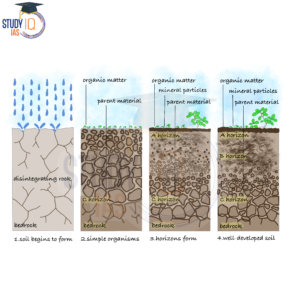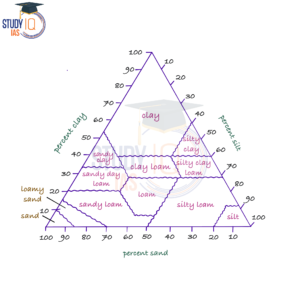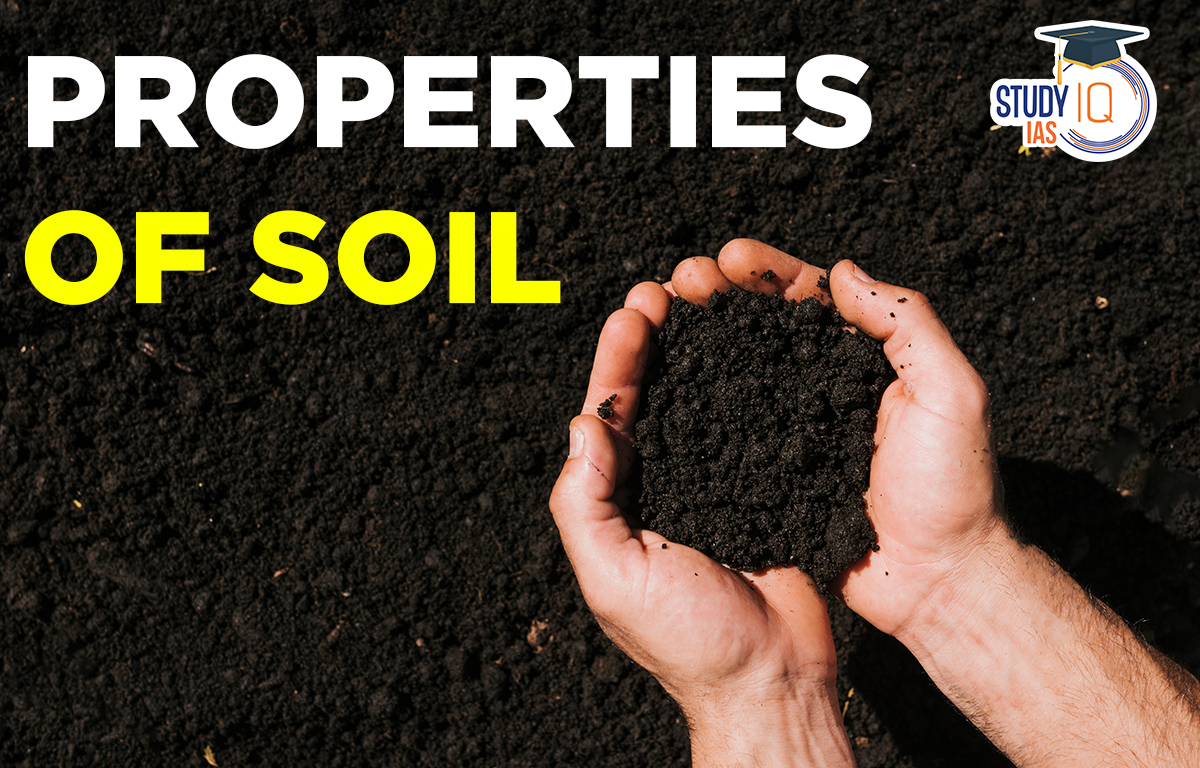Table of Contents
Properties of Soil
Soil is a complex mixture of minerals, organic matter, liquids, gases, and microorganisms that all work together to support life. It is the top layer of the earth’s surface made up of organic remains, clay, and rock materials on which plants grow. It promotes plant growth and life. It is constantly evolving due to a variety of physical, chemical, and biological processes such as Weathering and erosion. Soil has a density of 1.6 g/cm3.
Read about: Mountains of India
Structure of the Soil
Soil is composed of four main components: minerals, organic matter, water, and air. These components are arranged in different layers, or horizons, which make up the soil profile. The top layer of soil is called the topsoil, which is rich in organic matter and supports the majority of plant life. Below the topsoil is the subsoil, which contains more minerals and less organic matter. The deepest layer of soil is called the parent material, which is composed of weathered rock fragments and minerals. The specific composition and arrangement of these layers depend on various factors such as climate, vegetation, and geology.
Soil structure describes how soil particles are organised into a block, layer, or different structure. For example, during the summer, clay soil becomes blocky, and thus its structure is blocky.

The sandy soils found in Rajasthan have a grainy structure. Columnar structure; black soils have a columnar structure due to verticle cracks that developed during the dry season. Horizontal space between particles in a plate structure. River valleys in the flood plains form the layer structure of khadar deposits every year.
Read about: Physiography of India
Physical Properties of Soil
Colour, texture, structure, porosity, density, temperature, and air are all physical Properties of Soil. Soil colours vary greatly from place to place and indicate properties such as organic matter, water, and redox conditions. The types of soil particles and their arrangement influence soil texture, structure, porosity, and density.
1. Soil Texture
The proportion of sand, silt, and clay-sized particles that make up the mineral fraction of the soil (such as loam, sandy loam, or clay) is referred to as soil texture. Sand and silt are unimportant to the soil because they contribute nothing to the soil’s ability to restore water and nutrients. Clay is important in soil because it’s small and has a large surface area, helping to store water and nutrients. Soil texture affects how much water it can hold, how fast water moves through it, and how easy it is to work with, as well as its fertility.
2. Water Absorption
Because of its porosity, soil can absorb water. The capacity of different soil types to hold water varies. Sand absorbs significantly less water than clay. Sandy soil has a lower water-holding capacity than clay and loamy soil. Clay soil is more water-retaining than sandy soil.
3. Soil Color
Soil color varies based on the type of iron it contains. Brown, yellow, or red colors come from oxidized iron. Darker soil usually means more organic material. Red soil has iron oxide, while black soil is rich in minerals and humus.
4. Porosity
- Porosity refers to the space between particles in the soil.
- Pores aid in the retention of air, water, and microorganisms.
- Porous soil is soil that has a large pore.
- Because sandy soil has half the porosity of clay soil, clay soil has a higher water or air-holding capacity than sandy soil.
- More porosity means more capacity to hold water or air.
5. Soil Permeability
Permeability refers to the rate at which moisture or air passes through the soil. Water flows easily through sandy soil but not clay soil thus, sandy soil is more permeable than clay soil. The soil with the most pores is the least permeable.
Read about: Important Mountain Passes in India
Chemical Properties of Soil
The chemical properties of soil come from minerals, organic matter, and nutrients. These elements work together to affect soil pH, nutrient availability, and chemical reactions. Soil pH shows how acidic or alkaline the soil is, which helps determine what plants can grow there. It is influenced by minerals, organic matter, and the activities of soil organisms.
- pH is determined by the relative concentration of hydrogen(H+) ions. Acidity increases as H+ concentration increases and pH values decrease.
- If the pH of the soil is less than 6.5, it is said to be acidic.
- If the pH of the soil exceeds 7, it is considered alkaline.
- Plants receive the most nutrients when the pH of the soil is between 6.5 and 7.
- Podzol and Forest Soil from the Taiga region are examples of acidic soil, with pH values ranging from 3 to 5.
Biological Properties of Soil
Soil is home to many living organisms, including bacteria, fungi, insects, worms, and small mammals. These organisms enrich the soil by breaking down organic matter and releasing nutrients that help plants grow. Bacteria indicate neutral soil, while fungi suggest acidic conditions. They also create channels in the soil, improving water and air movement, which benefits root growth. Additionally, some microorganisms help convert nitrogen from the air into a form that plants can use, called nitrogen fixation. Human activities, like farming and using fertilizers or pesticides, can impact soil health and biodiversity.
Characteristics of Soil
Soils are classified into six types based on their chemical composition, which determines how water and nutrients are retained and which crops grow best in them. Soil composition can be sand, clay, loam, chalk, peat, or silt-based, and many soil systems will have patches with higher concentrations of one component than another. Let us break down each soil type into its key features and characteristics, as well as how this translates in an agricultural context.

1. Sandy
- Suitable for Mediterranean herbs (rosemary, thyme, oregano) and trees (bay laurel, fig, olive)
- Good for root vegetables (carrots, beetroot, parsnips, radish, turnips)
- Grainy, light texture, easy to work with
- Drains water quickly, soft and malleable for digging
- Lower nutrient availability, heats up and dries out quickly
- Lower average pH, ideal for slightly acidic soil-loving plants
- Best for crops needing well-draining soil and hot, dry conditions
2. Clay
- Heavy and poor drainage
- Small particles make soil firm and compacted
- Few pathways for water to drain
- High in nutrients and minerals
- Often undesirable for farming due to poor drainage
- Some fruit trees and Brassica vegetables can tolerate clay
- Best mixed with loam for better drainage and nutrient absorption
3. Silty
- Silky and soft texture
- Quite fertile with good nutrient density
- Poor drainage, may need amendments for crops
- Softer and lighter than clay soils, don’t compact easily
- Lack strong structure, improved by planting perennial crops
- Best for perennial bushes and trees in moist, fertile conditions
4. Loamy
Loamy soils are defined as a balance of the three soil types mentioned previously: sand, clay, and silt. This is one of the most desirable and fertile soil types because it has the ‘best of both worlds’ characteristics, which means it has the advantages of all three soil types.
- Good drainage and high nutrient availability
- Well-structured profile
- Slow to heat up and cool, providing stable temperatures for crops
- Ideal for most fruits and vegetables
- Delicate balance of three soil types, needs maintenance
- Crop rotation helps maintain soil balance and nutrients
5. Chalk
- High in calcium carbonate, making them alkaline
- Formed on top of limestone or chalk bedrock
- Best for farming when mixed with organic matter and sulfuric fertilizers
- Excellent drainage due to larger particles and rocks
- Can hinder the growth of some root vegetables
6. Peat
Peaty soil forms because of the high amount of organic material that builds up in humid climates. It has low levels of phosphorus and potash.
- Peaty soils originate in the areas of heavy rainfall where adequate drainage is not available
- You can find peaty soil in some districts of Kerala, and marshy soil along the coasts of Tamil Nadu, Bihar, Uttarakhand, and the Sundarbans in West Bengal.
- Peaty soil is black and very acidic
- Rich in Organic matter, highly saline, but deficient in Phosphate and Potash
Determining Soil Types
You can identify your soil type by feeling its texture how gritty or smooth it is and seeing how it breaks apart or sticks together. You can also test it by placing it in water to see how the particles settle. For a more accurate analysis, you can use a soil test kit. The color of the soil can also help identify its type. For example, peat soil is dark, sometimes almost black, while chalk soil has a white dust or visible chalk particles that make it easy to recognize.
Properties of Soil UPSC
Soil is a combination of rock debris and organic materials that form on the earth’s surface. Relief, parent material, climate, vegetation and other life forms, and time are the major factors influencing soil formation. Aside from these, human activities have a significant impact on it.


 Role of Teachers in Educations, Student ...
Role of Teachers in Educations, Student ...
 India's achievements after 75 years of I...
India's achievements after 75 years of I...
 Bal Gangadhar Tilak Biography, Achieveme...
Bal Gangadhar Tilak Biography, Achieveme...

























